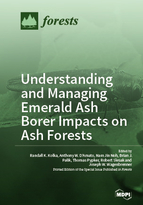Understanding and Managing Emerald Ash Borer Impacts on Ash Forests
A special issue of Forests (ISSN 1999-4907). This special issue belongs to the section "Forest Ecophysiology and Biology".
Deadline for manuscript submissions: closed (28 February 2018) | Viewed by 105571
Special Issue Editors
Interests: biogeochemistry; soil carbon sequestration; land management across terrestrial and aquatic ecosystems; water, nutrient and carbon cycling; climate change
Special Issues, Collections and Topics in MDPI journals
Interests: silviculture and applied forest ecology; forest management; regeneration; stand dynamics and development
Interests: biogeochemistry; carbon and nitrogen dynamics; plant and soil interaction; applied forest ecology; forest management; climate change
Interests: disturbance ecology; ecological forestry; stand dynamics and development; plant community composition and diversity; regeneration
Special Issues, Collections and Topics in MDPI journals
Interests: micrometeorology; plant ecophysiology; hydrology; disturbance ecology; ecosystem management; climate change
Interests: sustainable forest practices; forest management; forest soils; applied forest ecology; hydrology; ecosystem function
Interests: forest hydrology; disturbance ecology; forest practices and management; climate change
Special Issue Information
Dear Colleagues,
The emerald ash borer (EAB) is rapidly spreading throughout Eastern North America and devastating ecosystems where ash is a component tree. This rapid and sustained loss of ash trees has already resulted in ecological impacts on both terrestrial and aquatic ecosystems and is projected to be even more severe as EAB invades ash dominated wetlands of the western Great Lakes region. We propose a Special Issue that will address current research documenting ecological impacts of EAB in forest ecosystems, as well as management approaches to mitigate those impacts. Prospective authors are invited to contribute original researches to this Special Issue of Forests. Topics may include, but are not limited to: Managements of ash forests and potential replacements, nutrient and vegetation dynamics, greenhouse gas emissions and carbon sequestration and cycling, hydrologic impacts, and pre or post-infestation silvicultural approaches or management strategies.
Dr. Randall K. Kolka
Guest Editor
Dr. Anthony D'Amato
Dr. Nam Jin Noh
Dr. Brian J. Palik
Dr. Tomas Pypker
Dr. Robert Slesak
Dr. Joseph W. Wagenbrenner
Co-Guest Editors
Manuscript Submission Information
Manuscripts should be submitted online at www.mdpi.com by registering and logging in to this website. Once you are registered, click here to go to the submission form. Manuscripts can be submitted until the deadline. All submissions that pass pre-check are peer-reviewed. Accepted papers will be published continuously in the journal (as soon as accepted) and will be listed together on the special issue website. Research articles, review articles as well as short communications are invited. For planned papers, a title and short abstract (about 100 words) can be sent to the Editorial Office for announcement on this website.
Submitted manuscripts should not have been published previously, nor be under consideration for publication elsewhere (except conference proceedings papers). All manuscripts are thoroughly refereed through a single-blind peer-review process. A guide for authors and other relevant information for submission of manuscripts is available on the Instructions for Authors page. Forests is an international peer-reviewed open access monthly journal published by MDPI.
Please visit the Instructions for Authors page before submitting a manuscript. The Article Processing Charge (APC) for publication in this open access journal is 2600 CHF (Swiss Francs). Submitted papers should be well formatted and use good English. Authors may use MDPI's English editing service prior to publication or during author revisions.
Keywords
- emerald ash borer
- ash forests
- tree mortality
- vegetation and stand dynamics
- species replacement
- silviculture and management
- water, carbon and nutrient dynamics
- biogeochemistry









